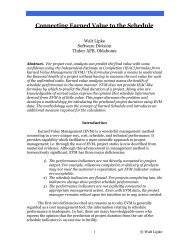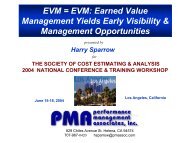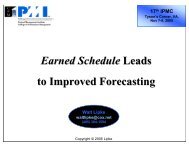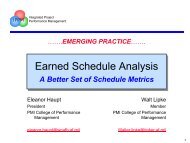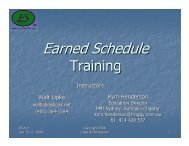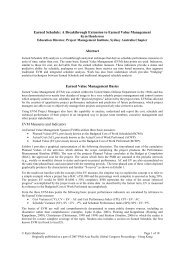The Measurable News Earned Schedule Application to Small Projects
The Measurable News Earned Schedule Application to Small Projects
The Measurable News Earned Schedule Application to Small Projects
Create successful ePaper yourself
Turn your PDF publications into a flip-book with our unique Google optimized e-Paper software.
<strong>The</strong> <strong>Measurable</strong> <strong>News</strong><br />
<strong>Earned</strong> <strong>Schedule</strong> <strong>Application</strong> <strong>to</strong><br />
<strong>Small</strong> <strong>Projects</strong><br />
Abstract<br />
S<strong>to</strong>p work and down time conditions, sometimes occurring for small projects, impact the values computed for<br />
<strong>Earned</strong> <strong>Schedule</strong> indica<strong>to</strong>rs. <strong>The</strong> dis<strong>to</strong>rted values, in turn, have the potential <strong>to</strong> affect management decisions. To<br />
address the problem, a special calculation method for handling these conditions is presented and examined using<br />
four sets of notional data. Comparisons of the computed values from special and normal ES calculation methods<br />
indicate significant improvement using the special calculations.<br />
Walt Lipke, PMI ® Oklahoma City<br />
Chapter<br />
Introduction<br />
<strong>Earned</strong> schedule (ES) is an extension<br />
<strong>to</strong> earned value management (EVM)<br />
providing the capability of schedule<br />
analysis. 1 ES was introduced in 2003<br />
by my article “<strong>Schedule</strong> Is Different”<br />
[Lipke, 2003]. From 2003 until now,<br />
much has happened. For those applying<br />
ES, the method is broadly considered<br />
<strong>to</strong> be a significant advancement<br />
<strong>to</strong> the practice of EVM. ES has propagated<br />
across the world, including<br />
the USA, Australia, United Kingdom,<br />
Belgium, Spain, Canada, India, Japan,<br />
and other countries as well. It is being<br />
used across all industries applying<br />
EVM for all sizes of projects.<br />
Furthermore, the method is being<br />
used in research, instructed in several<br />
universities, and is included in recent<br />
project management texts and the<br />
newer EVM analysis <strong>to</strong>ols. Currently,<br />
an appendix describing ES is being<br />
prepared for inclusion in the PMI ®<br />
Practice Standard for <strong>Earned</strong> Value<br />
Management [PMI, 2005].<br />
<strong>The</strong> measure of ES has provided<br />
schedule analysis and forecasting capability<br />
<strong>to</strong> those using EVM, previously<br />
not believed possible. Parallel<br />
<strong>to</strong> forecasting final cost using EVM<br />
measures, ES facilitates a simple calculation<br />
for the forecasting of project<br />
duration and completion dates.<br />
Furthermore, it has been shown that<br />
the forecasting is enhanced through<br />
the application of statistical methods<br />
[Lipke, 2009]. Additionally, another<br />
measure has been derived from ES,<br />
“<strong>Schedule</strong> Adherence” [Lipke, 2009].<br />
This measure, in turn, has provided<br />
the capability <strong>to</strong> perform detailed<br />
analysis, yielding identification of process<br />
constraints and impediments and<br />
specific tasks having the likelihood<br />
of future rework. Recently, additional<br />
calculation methods have been developed<br />
for determining the value of<br />
the out of sequence work and the rework<br />
cost caused by imperfect schedule<br />
adherence [Lipke, 2010]. <strong>The</strong>se<br />
advancements are freely available for<br />
study and exploration through the literature<br />
and calculation <strong>to</strong>ols at the ES<br />
website, www.earnedschedule.com.<br />
Broadly speaking, the ES methods<br />
have proven <strong>to</strong> perform very well.<br />
However, there are conditions during<br />
execution, generally for small, shortduration<br />
projects, that can cause error<br />
in the calculated values for the ES indica<strong>to</strong>rs<br />
and duration forecasts. <strong>The</strong>se<br />
conditions are the following:<br />
• Down Time — periods within<br />
the schedule where no work is<br />
scheduled<br />
• S<strong>to</strong>p Work — periods during execution<br />
where management has<br />
halted performance<br />
However, it is worthy <strong>to</strong> note that even<br />
when down time and work s<strong>to</strong>p conditions<br />
are encountered, ES calculations<br />
converge <strong>to</strong> the correct duration<br />
forecast and the final schedule variance<br />
result. <strong>The</strong> remainder of this article<br />
will discuss the method of handling<br />
the two conditions and describe the results<br />
from application <strong>to</strong> notional data.<br />
Down Time and S<strong>to</strong>p Work<br />
Let’s begin with a clear understanding<br />
of the terminology “down time” and<br />
“s<strong>to</strong>p work.” Table 1 shows cumulative<br />
earned value (EV) and planned value<br />
(PV) for 30 periods of performance.<br />
You will note that EV and PV are<br />
shown preceded by an “i.” <strong>The</strong> i denotes<br />
that the strings of data are discontinuous,<br />
i.e., they are “interrupted.”<br />
First, viewing the iEV cum<br />
rows, it is observed<br />
that periods 6 and 7 do not<br />
have data and instead show “XX.” <strong>The</strong><br />
XX entries indicate that management<br />
imposed a s<strong>to</strong>p work for those two periods<br />
of time. For the iPV cum<br />
rows, it<br />
should be unders<strong>to</strong>od that XX entered<br />
for the periods 15 through 18, indicates<br />
no work was planned, i.e., four<br />
down periods of time.<br />
<strong>The</strong> XX periods impact the ES indica<strong>to</strong>rs<br />
and the forecast duration and<br />
completion date. <strong>The</strong> indica<strong>to</strong>rs may<br />
not describe the true performance<br />
while, generally, the forecast is caused<br />
<strong>to</strong> have larger error. When management<br />
imposes a s<strong>to</strong>p work, the opportunity<br />
has been removed <strong>to</strong> accrue EV.<br />
<strong>The</strong> impact of down time is somewhat<br />
different. It extends the planned period<br />
of completion. However, manage-<br />
1<br />
This article assumes a reasonable understanding of EVM and ES. If more explanation of EVM is desired see Humphreys (2002). For the fundamentals<br />
of ES see Lipke (2009).<br />
25
<strong>The</strong> <strong>Measurable</strong> <strong>News</strong><br />
ment can choose <strong>to</strong> not have the down<br />
period(s) and instead continue <strong>to</strong><br />
work. As seen from the iEV cum<br />
entries<br />
in Table 1, the project manager (PM)<br />
chose <strong>to</strong> work through the planned<br />
down periods (15 though 18), thereby<br />
minimizing the completion delinquency.<br />
Oppositely, if the plan had been followed,<br />
XX would instead appear for<br />
the iEV cum<br />
entries during the down time<br />
periods.<br />
<strong>Schedule</strong> Performance<br />
Indica<strong>to</strong>rs<br />
Table 2 displays the normal and<br />
amended, or special, ES indica<strong>to</strong>rs<br />
that account for the imposed s<strong>to</strong>p<br />
work. Observed for the periodic timebased<br />
schedule variances, SV(t) wk<br />
and iSV(t) wk<br />
both have a value of –1.0<br />
for the s<strong>to</strong>p work periods (6 and 7).<br />
Clearly, no work was accomplished;<br />
therefore, for both indica<strong>to</strong>rs, a period<br />
of opportunity <strong>to</strong> accrue EV was<br />
lost for each s<strong>to</strong>p work period. This<br />
fact is shown, as well, for the periodic<br />
schedule performance efficiencies<br />
SPI(t) wk<br />
and iSPI(t) wk<br />
; both are equal<br />
<strong>to</strong> zero for the two periods.<br />
Table 1. EV and PV data with s<strong>to</strong>p work and down time.<br />
Table 2. S<strong>to</strong>p work indica<strong>to</strong>rs.<br />
<strong>The</strong> cumulative values for the indica<strong>to</strong>rs<br />
in Table 2, however, show<br />
differences. <strong>The</strong> normal SPI(t) cum<br />
indicates<br />
schedule performance efficiency<br />
is decreasing during the s<strong>to</strong>p work,<br />
whereas the iSPI(t) cum<br />
value remains<br />
constant. If the project team had chosen<br />
<strong>to</strong> work and accomplished nothing,<br />
then decreasing performance is<br />
an expectation. In this case, there is<br />
no way of knowing if performance has<br />
changed; thus, the value for iSPI(t) cum<br />
remains at 0.6084, i.e., the value from<br />
the last performance period (5) in<br />
which work was not s<strong>to</strong>pped.<br />
<strong>The</strong> differences for the values of SV(t) cum<br />
and iSV(t) cum<br />
are the result of the impact<br />
from the planned down time. Two<br />
iSV(t) cum<br />
values are computed and<br />
shown in Table 2. One includes the<br />
impact of down time while the other<br />
does not. <strong>The</strong> two values are identified<br />
as iSV(t) cum<br />
DT and iSV(t) cum<br />
DT,<br />
respectively.<br />
Returning <strong>to</strong> the example computations,<br />
the four periods of down time<br />
(15–18) are in the future with respect<br />
<strong>to</strong> the s<strong>to</strong>p work periods (6–7). As<br />
such, they represent periods available<br />
for accomplishing work. For the special<br />
indica<strong>to</strong>r, iSV(t) cum<br />
DT, its value will<br />
be identical <strong>to</strong> SV(t) cum<br />
until the periods<br />
of down time occur. As Table 2 indicates,<br />
this is the condition for periods<br />
6 and 7 and, as shown, the values for<br />
SV(t) cum<br />
and iSV(t) cum<br />
DT are equal.<br />
<strong>The</strong> values in the column representing<br />
iSV(t) cum<br />
DT account for the available<br />
down time. Using the values in Table<br />
2, it can be deduced that adding the<br />
four periods of down time <strong>to</strong> SV(t) cum<br />
yields iSV(t) cum<br />
DT. As the down time<br />
periods occur, they accrue and no<br />
longer have potential for performing<br />
work. To obtain iSV(t) cum<br />
DT, the value<br />
of down time remaining is subtracted<br />
from iSV(t) cum<br />
DT. As an example, using<br />
the data from period 7, the number<br />
of down time periods (4) is subtracted<br />
from 0.0422 <strong>to</strong> yield –3.9578 for<br />
iSV(t) cum<br />
DT.<br />
Table 3 provides information about the<br />
indica<strong>to</strong>rs during the planned down time<br />
periods. <strong>The</strong> normal and special periodic<br />
SPI(t) values are equal, as we should<br />
expect; the ES progress for the performance<br />
period is not affected by the down<br />
time. However, SPI(t) cum<br />
is shown <strong>to</strong> be<br />
less than iSPI(t) cum<br />
;<br />
the result of the<br />
previous s<strong>to</strong>p<br />
work periods. As<br />
expressed earlier,<br />
the true schedule<br />
performance<br />
efficiency is given<br />
by the special<br />
indica<strong>to</strong>r.<br />
<strong>The</strong> differences in<br />
the computed values<br />
for SV(t) cum<br />
and the two<br />
iSV(t) cum<br />
indica<strong>to</strong>rs<br />
were described<br />
in the<br />
discussion of<br />
Table 2. To assure<br />
understanding<br />
a few<br />
26
<strong>The</strong> <strong>Measurable</strong> <strong>News</strong><br />
calculations for period 15 from Table 3<br />
follow:<br />
iSV(t) cum<br />
DT = SV(t) cum<br />
+ Total Planned<br />
Down Time<br />
= –4.8981 + 4.0<br />
= –0.8981 periods<br />
iSV(t) cum<br />
DT = iSV(t) cum<br />
DT – Down<br />
Time Remaining<br />
= –0.8981 – 3.0<br />
= –3.8981 periods<br />
Although the periodic values are equal<br />
for the two methods of computing schedule<br />
performance efficiency, those for<br />
schedule variance are not. Down time<br />
causes the periodic values of the normal<br />
and special schedule variance <strong>to</strong> differ<br />
by 1.0; i.e., iSV(t) wk<br />
is equal <strong>to</strong> SV(t) wk<br />
plus 1.0 <strong>to</strong> account for the down time associated<br />
with the period of performance.<br />
As an example, when the project s<strong>to</strong>ps<br />
work in accordance with the scheduled<br />
down time, SV(t) wk<br />
is equal <strong>to</strong> –1.0;<br />
the normal indica<strong>to</strong>r is influenced by the<br />
s<strong>to</strong>p work only. However, because of the<br />
down time, iSV(t) wk<br />
is equal <strong>to</strong> 0<br />
(–1.0 + 1.0 = 0).<br />
<strong>The</strong> message <strong>to</strong><br />
be taken from<br />
this discussion is<br />
when s<strong>to</strong>p work<br />
or down time conditions<br />
occur, the<br />
normal indica<strong>to</strong>rs<br />
do not accurately<br />
portray performance<br />
and have<br />
the potential <strong>to</strong><br />
cause inappropriate<br />
management<br />
decisions. <strong>The</strong><br />
special indica<strong>to</strong>rs<br />
provide better<br />
management<br />
information. At<br />
this point it may<br />
be confusing as<br />
<strong>to</strong> why there are<br />
two values for<br />
iSV(t) cum<br />
. <strong>The</strong><br />
iSV(t) cum<br />
DT is the<br />
true schedule<br />
variance and is<br />
Table 3. Down time indica<strong>to</strong>rs.<br />
Table 4. S<strong>to</strong>p work / down time forecast.<br />
intended for project performance analysis.<br />
<strong>The</strong> iSV(t) cum<br />
DT is made available<br />
for management <strong>to</strong> know the position<br />
of the project should the schedule be<br />
compressed such that the remaining<br />
down time is taken away.<br />
Forecasts<br />
A significant advantage from applying<br />
ES is that the method provides the<br />
capability <strong>to</strong> forecast the project duration<br />
and the expected completion<br />
date. Other methods exist; however,<br />
through studies it has been shown<br />
that ES is the most reliable forecasting<br />
method using EVM data [Lipke, 2008]<br />
[Vanhoucke, 2007]. Nevertheless, in<br />
the introduction segment of this article,<br />
it was mentioned that the interrupting<br />
conditions cause some amount of error<br />
in the ES forecasts. At the conclusion<br />
of the introduction, emphasis was<br />
made that, even with the interrupting<br />
conditions, the ES forecasting always<br />
converges <strong>to</strong> the actual duration.<br />
Knowing this, the question arises: Is<br />
it worthwhile <strong>to</strong> calculate the forecast<br />
differently? I’ll attempt <strong>to</strong> show the improvement<br />
is significant enough that<br />
when the interrupting conditions of<br />
work s<strong>to</strong>p and down time arise, the alternative<br />
method should be used.<br />
<strong>The</strong> idea of the alternative calculation<br />
is fairly simple yet complex. In general,<br />
the forecast is made as if the interrupting<br />
conditions are not present. <strong>The</strong>n,<br />
using the undis<strong>to</strong>rted forecast, add in<br />
the interruption effects as they occur.<br />
Thus, <strong>to</strong> begin, instead of computing<br />
the forecast using the normal SPI(t) cum<br />
,<br />
the true performance index, iSPI(t) cum<br />
,<br />
is used.<br />
<strong>The</strong> first step, as previously described,<br />
is <strong>to</strong> calculate an initial forecast as if<br />
the planned down time does not exist.<br />
<strong>The</strong>refore, the period of performance<br />
used in the calculation is shortened;<br />
the numera<strong>to</strong>r in the forecasting formula<br />
becomes the planned duration<br />
(PD) minus the <strong>to</strong>tal number of down<br />
time periods (DT T<br />
). Having the numer-<br />
27
<strong>The</strong> <strong>Measurable</strong> <strong>News</strong><br />
a<strong>to</strong>r and denomina<strong>to</strong>r, the normal ES<br />
forecasting formula, IEAC(t) = PD /<br />
SPI(t) cum<br />
, is modified <strong>to</strong> become the initial<br />
forecast formula: IEAC(t)sp1 = (PD<br />
– DT T<br />
) / iSPI(t) cum<br />
.<br />
From this initial formulation, the impact<br />
of the s<strong>to</strong>p work and down time conditions<br />
are introduced in<strong>to</strong> the calculation<br />
as they occur. <strong>The</strong> running <strong>to</strong>tal of s<strong>to</strong>p<br />
work (SW) periods is added <strong>to</strong> the initial<br />
formula, creating a second forecast<br />
expression: IEAC(t)sp2 = IEAC(t)sp1<br />
+ SW.<br />
For the final forecast formula, IEAC(t)sp,<br />
the <strong>to</strong>tal number of down time periods<br />
(DT T<br />
) is added <strong>to</strong> IEAC(t)sp2.<br />
As the down time periods occur, they<br />
are counted (DT L<br />
) and then subtracted<br />
from DT T<br />
, thereby reducing the remaining<br />
potential for void performance<br />
periods. At this point, the formulation<br />
of the final forecast is complete with<br />
one exception. In the event the forecast<br />
from IEAC(t)sp2 computes a duration<br />
(SP2) less than PD, the number<br />
of down time periods between SP2<br />
and PD is counted. This conditional<br />
quantity (DT C<br />
) is included as a subtraction,<br />
which completes the special<br />
forecasting formula:<br />
IEAC(t)sp = (PD – DT T<br />
) / iSPI(t) cum<br />
+<br />
SW + DT T<br />
– DT L<br />
– DT C<br />
Now, we will use this formula and examine<br />
its forecasting performance.<br />
From the data shown in Table 1, the<br />
normal ES forecast, IEAC(t), is computed<br />
and compared <strong>to</strong> the special ES<br />
forecast. <strong>The</strong> computed results are<br />
compiled by period of performance in<br />
Table 4. As seen in the table, the two<br />
forecasts begin with comparable values.<br />
When s<strong>to</strong>p work periods 6 and 7<br />
occur, IEAC(t) increases significantly<br />
more than does the special forecast.<br />
Over the two periods, IEAC(t) increases<br />
from the value of 44.4 <strong>to</strong> 62.1 periods,<br />
whereas IEAC(t)sp increases by<br />
only two from 41.8 <strong>to</strong> 43.8.<br />
For periods 8–14, both forecasts decrease<br />
with the IEAC(t) value consistently<br />
higher; the difference between the<br />
two begins at 14.2 periods and narrows<br />
<strong>to</strong> 4.9. During the down time periods, 15<br />
through 18, each forecast continues <strong>to</strong><br />
decrease, with the IEAC(t) values higher<br />
by 5.5 <strong>to</strong> 6.9 periods. Once the down<br />
time conditions have passed, both forecasts<br />
quickly converge <strong>to</strong> values close<br />
<strong>to</strong> the actual duration. For this set of<br />
data, it is reasonably clear that IEAC(t)<br />
sp produces a better forecast than<br />
IEAC(t). Next, four cases are examined<br />
<strong>to</strong> further evaluate the forecasting of the<br />
two methods, when interrupting conditions<br />
are present.<br />
Case Comparisons<br />
<strong>The</strong> four cases <strong>to</strong> be examined are<br />
characterized as follows:<br />
• Case 1 is an early finish project<br />
with a three week s<strong>to</strong>p work<br />
condition.<br />
• Case 2 is a late finish with work<br />
s<strong>to</strong>pped during four weeks of<br />
down time.<br />
• Case 3 is a late finish with work<br />
accomplished through four weeks<br />
of down time.<br />
• Case 4 is a late finish having 2<br />
weeks of s<strong>to</strong>p work followed by 4<br />
weeks of worked down time.<br />
For each case a figure is presented<br />
containing a graph and column chart<br />
(Figures 1–4). <strong>The</strong> graph plots by performance<br />
period the special and normal<br />
forecasts along with the planned<br />
and actual durations. <strong>The</strong> column<br />
charts are comparisons of the standard<br />
deviation of the forecasts from<br />
the final duration for four ranges of<br />
percent complete. <strong>The</strong> ranges are 10–<br />
100%, 25–100%, 50–100%, and 75–<br />
100%. <strong>The</strong> graph provides a good<br />
visual for how well the IEAC(t)sp and<br />
IEAC(t) forecasting methods perform.<br />
Separately, the column charts display<br />
the characteristic of convergence <strong>to</strong><br />
the actual duration.<br />
<strong>The</strong> performance depicted in Figure<br />
1 is of a project planned for 28 periods<br />
that completes in 26. <strong>The</strong> effect<br />
of three weeks of s<strong>to</strong>p work is observed<br />
in the graph. <strong>The</strong> normal forecast,<br />
IEAC(t), increases dramatically<br />
Figure 1. Early finish — 3 week s<strong>to</strong>p work (11–13).<br />
2<br />
Case 4 is the example project discussed in the previous sections of the article.<br />
28
<strong>The</strong> <strong>Measurable</strong> <strong>News</strong><br />
during the s<strong>to</strong>p work, while the special<br />
forecast increases at a slower rate. By<br />
period 15, the IEAC(t)sp forecast has<br />
converged and is accurately forecasting<br />
the final duration. After the s<strong>to</strong>p<br />
work period the normal forecast gradually<br />
decreases, eventually converging<br />
<strong>to</strong> the actual duration.<br />
<strong>The</strong> Figure 1 column chart shows that<br />
both methods of forecasting converge.<br />
<strong>The</strong> characteristic of convergence is<br />
indicated by the standard deviation<br />
becoming smaller and smaller as the<br />
data range becomes more biased <strong>to</strong>ward<br />
completion. Each forecasting<br />
method indicates increasing accuracy<br />
as the project progresses; however,<br />
it is observed <strong>to</strong> be much more pronounced<br />
for IEAC(t)sp.<br />
Figure 2 portrays the performance of<br />
a late finish project, planned for 27 periods,<br />
in which there are four periods<br />
of down time. Just as for Figure 1, the<br />
impact of s<strong>to</strong>pping work, as planned,<br />
causes the normal forecast <strong>to</strong> increase<br />
rapidly. <strong>The</strong> special forecast increases,<br />
as well, but the durations calculated<br />
are shorter. It is seen that the special<br />
forecast very accurately predicts<br />
the final duration beginning at period<br />
19 with the normal forecast becoming<br />
comparable at period 21. For Case<br />
2 the column chart indicates convergence<br />
for both methods with the special<br />
forecast considerably better for the<br />
two larger percent complete ranges<br />
and marginally better for the two shorter<br />
ranges.<br />
<strong>The</strong> Case 3 project is planned for 27<br />
periods including four periods of down<br />
time. During execution, the manager<br />
chose <strong>to</strong> work through the down time,<br />
thereby reducing the late completion <strong>to</strong><br />
one period. From the graph it is seen<br />
that the normal forecast sharply decreases<br />
during the scheduled period<br />
of down time, while the special forecast<br />
decreases more gradually. <strong>The</strong><br />
special forecast becomes very accurate<br />
beginning at period 17, while the<br />
normal forecast doesn’t achieve comparable<br />
accuracy until period 24. Each<br />
Figure 2. Late finish — 4 periods of down time (15–18).<br />
Figure 3. Late finish – work through 4 periods of down time (15–18).<br />
29
<strong>The</strong> <strong>Measurable</strong> <strong>News</strong><br />
Figure 4. Late finish – 2 period s<strong>to</strong>p (6–7) and work 4 down time periods (15–18).<br />
method shows convergence from the<br />
column chart with the special method<br />
consistently showing better forecasting<br />
accuracy.<br />
Figure 4 portrays the performance for a<br />
27 period project having a combination<br />
of interruptions. During the execution,<br />
performance is halted for two periods.<br />
Later, <strong>to</strong> minimize the impact of the delay,<br />
the project team works through the<br />
four periods of down time, delivering<br />
the product three periods late.<br />
<strong>The</strong> graph and chart in Figure 4 depict<br />
the performance for Case 4. Clearly,<br />
the forecasts from IEAC(t)sp are better.<br />
<strong>The</strong>y are shown <strong>to</strong> be more accurate<br />
for every set of computed values after<br />
period one. Likewise, the column chart<br />
illustrates that IEAC(t)sp calculations<br />
provided better forecasting and convergence<br />
for all performance data ranges.<br />
<strong>The</strong> last three sentences in the previous<br />
paragraph portray, in general,<br />
the comparison results for cases 1, 2,<br />
and 3 as well. From the case examinations,<br />
it can be stated that when the interruptions<br />
of s<strong>to</strong>p work and down time<br />
are encountered, the special method<br />
can be expected <strong>to</strong> produce more<br />
accurate forecasting results. Due <strong>to</strong><br />
the case findings and their consistency,<br />
the special method is recommended<br />
for use.<br />
30<br />
Summary<br />
ES has been shown through research<br />
and use over several years <strong>to</strong> be a reliable<br />
schedule analysis extension <strong>to</strong><br />
EVM. For large projects, s<strong>to</strong>p work<br />
and down time conditions occurring for<br />
small portions of the project, in most<br />
instances, would not have much impact<br />
on the ES time based indica<strong>to</strong>rs<br />
or the duration and completion<br />
date forecasts. However, it is a different<br />
matter for small projects. <strong>The</strong> interrupting<br />
conditions will usually dis<strong>to</strong>rt<br />
the ES indica<strong>to</strong>rs and forecasts, possibly<br />
enough <strong>to</strong> affect management<br />
decisions.<br />
Special calculation methods were introduced<br />
for enhancing the application<br />
of ES <strong>to</strong> small projects. <strong>The</strong> methods<br />
were described for the time-based<br />
schedule performance indica<strong>to</strong>rs and<br />
the forecasting of duration and completion<br />
date. <strong>The</strong> improvement <strong>to</strong> the<br />
indica<strong>to</strong>rs from the special methods<br />
was illustrated through an example set<br />
of EVM data.<br />
<strong>The</strong> special and normal forecasting<br />
methods were applied <strong>to</strong> four sets of<br />
EVM data, having various combinations<br />
of s<strong>to</strong>p work and down time conditions.<br />
For each case, forecasts were<br />
made using both calculations methods.<br />
<strong>The</strong> forecasts were then compared<br />
from two perspectives. Graphs<br />
were made for the forecast results<br />
of IEAC(t) and IEAC(t)sp by period.<br />
Included on the graphs are the<br />
planned and actual durations, as well.<br />
Additionally, column charts for four<br />
ranges of percent complete were constructed<br />
depicting the standard deviation<br />
of the forecast results with respect<br />
<strong>to</strong> the final duration.<br />
For all four performance scenarios,<br />
the comparisons made in the graphs<br />
and charts clearly indicate that IEAC(t)<br />
sp reliably produced better forecasts.<br />
Although small, notional, data sets<br />
were used, the results are compelling.<br />
Thus, for small projects encountering<br />
s<strong>to</strong>p work and down time conditions,<br />
the special ES method is recommended<br />
for calculating time-based indica<strong>to</strong>rs<br />
and forecasts.<br />
Final Comment<br />
Although the calculations <strong>to</strong> implement<br />
the special method are not difficult,<br />
they are incredibly tedious and the<br />
computations are mistake prone. To<br />
facilitate the application of ES for small<br />
projects subject <strong>to</strong> the interruptions of<br />
down time and s<strong>to</strong>p work, a calcula<strong>to</strong>r<br />
has been posted <strong>to</strong> the ES website<br />
(www.earnedschedule.com). <strong>The</strong> special<br />
ES calcula<strong>to</strong>r, ES calcula<strong>to</strong>r v1a<br />
(special cases), is freely downloadable<br />
from the “ES Calcula<strong>to</strong>r” website page.<br />
References<br />
Humphreys, Gary. 2002. Project<br />
Management Using <strong>Earned</strong> Value,<br />
Orange, CA: Humphreys & Associates.<br />
Lipke, Walt. 2003. “<strong>Schedule</strong> Is<br />
Different,” <strong>The</strong> <strong>Measurable</strong> <strong>News</strong>,<br />
March: 10–15.<br />
Lipke, Walt. 2008. “Project Duration<br />
Forecasting: Comparing <strong>Earned</strong> Value
<strong>The</strong> <strong>Measurable</strong> <strong>News</strong><br />
Management Methods <strong>to</strong> <strong>Earned</strong><br />
<strong>Schedule</strong>,” CrossTalk, December: 10–15.<br />
Lipke, Walter H. 2009. <strong>Earned</strong><br />
<strong>Schedule</strong>, Raleigh, NC: Lulu<br />
Publishing.<br />
Lipke, Walt. 2010. <strong>Schedule</strong><br />
Adherence and Rework. Europe<br />
<strong>Earned</strong> Value Analysis Conference,<br />
Ghent, Belgium (www.eva-europe.<br />
eu/2010/)<br />
Project Management Institute. 2005.<br />
Practice Standard for <strong>Earned</strong> Value Management,<br />
New<strong>to</strong>wn Square, PA: PMI ® .<br />
Vanhoucke, M., and S. Vandevoorde.<br />
2007. A Simulation and Evaluation<br />
of <strong>Earned</strong> Value Metrics <strong>to</strong> Forecast<br />
Project Duration. Journal of the<br />
Operations Research Society,<br />
Oc<strong>to</strong>ber, 58: 1361–1374<br />
About the Author<br />
Walt Lipke retired<br />
in 2005 as deputy<br />
chief of the<br />
Software Division<br />
at Tinker Air Force<br />
Base. He has over<br />
35 years of experience<br />
in the<br />
development,<br />
maintenance, and management of software<br />
for au<strong>to</strong>mated testing of avionics.<br />
During his tenure, the division achieved<br />
several software process improvement<br />
miles<strong>to</strong>nes, including the coveted<br />
SEI/IEEE award for Software Process<br />
Achievement. Mr. Lipke has published<br />
several articles and presented at conferences,<br />
internationally, on the benefits<br />
of software process improvement<br />
and the application of EVM and statistical<br />
methods <strong>to</strong> software projects. He is<br />
the crea<strong>to</strong>r of the technique ES, which<br />
extracts schedule information from<br />
earned value data. Mr. Lipke is a graduate<br />
of the USA DoD course for Program<br />
Managers. He is a professional engineer<br />
with a master’s degree in physics,<br />
and is a member of the physics<br />
honor society, Sigma Pi Sigma (SPS).<br />
Lipke achieved distinguished academic<br />
honors with the selection <strong>to</strong> Phi Kappa<br />
Phi (FKF). During 2007 Mr. Lipke received<br />
the PMI Metrics Specific Interest<br />
Group Scholar Award. Also in 2007, he<br />
received the PMI Eric Jenett Award for<br />
Project Management Excellence for his<br />
leadership role and contribution <strong>to</strong> project<br />
management resulting from his creation<br />
of the ES method. Mr. Lipke was<br />
selected for the 2010 Who’s Who in the<br />
World.<br />
KMSG Advanced Program Management Institute<br />
2011 Seminars in DC, Chicago, Bos<strong>to</strong>n, Phoenix, and Orlando<br />
ABOUT KM SYSTEMS GROUP Learn best practices for implementing cost effective EVM and gain<br />
control of your projects<br />
Our training is based on real world experience implementing EVM<br />
Systems for major federal agencies and government contrac<strong>to</strong>rs<br />
KMSG is the premier <strong>Earned</strong><br />
Value Management System<br />
(EVMS) implementation<br />
provider for organizations that<br />
include, FAA, NOAA, DOD,<br />
DOE, USCG, MIT Lincoln Lab,<br />
Unisys, and Battelle. We have<br />
conducted EVM Training for<br />
eight years and our training<br />
has enabled over 3,000<br />
professionals.<br />
INSTRUCTORS<br />
<strong>The</strong> instruc<strong>to</strong>rs, Kevin Martin,<br />
Mark Troisi, and Efrain<br />
Pacheco, PMP are thought<br />
leaders in EVM and have<br />
over 70 years of combined<br />
experience for organizations<br />
such as NASA, DOJ, DOD,<br />
and service as faculty<br />
members for the PMI EVM<br />
Community of Practice.<br />
EVM - Introduction, 2-day,<br />
14 PDUs, $995<br />
EVM - Advanced, 3-day,<br />
21 PDUs, $1,495<br />
Integrated Baseline Reviews,<br />
2-day,<br />
14 PDUs, $995<br />
Washing<strong>to</strong>n, DC - 9/12-9/13 & 12/5-12/6<br />
Chicago, IL - 7/18-7/19 Bos<strong>to</strong>n, MA - 8/15-8/16<br />
Phoenix, AZ - 10/17-10/18 Orlando, FL - 11/7-11/8<br />
Washing<strong>to</strong>n, DC - 9/14-9/16 & 12/7-12/9<br />
Chicago, IL - 7/20-7/22 Bos<strong>to</strong>n, MA - 8/17-8/19<br />
Phoenix, AZ - 10/19-10/21 Orlando, FL - 11/9-11/11<br />
Washing<strong>to</strong>n, DC - 9/19-9/20 & 12/12-12/13<br />
Chicago, IL - 7/25-7/26 Bos<strong>to</strong>n, MA - 8/22-8/23<br />
Phoenix, AZ - 10/24-10/25 Orlando, FL - 11/14-11/15<br />
Basic + Advanced 5-day 35 PDUs $1,995 / Advanced + IBR 5-day 35 PDUs $1,995<br />
Basic + Advanced + IBR 7-day 49 PDUs $2,495<br />
DISCOUNTS<br />
10% for prepayment 31 days in advance 10% for groups of 3 or more attendees<br />
20% for groups of 3 or more attendees prepaid 31 days in advance<br />
REGISTRATION<br />
Registration is completed online at www.kmsystemsgroup.com/training.html<br />
QUESTIONS?<br />
703.682.6856<br />
training@kmsystemsgroup.com<br />
31



